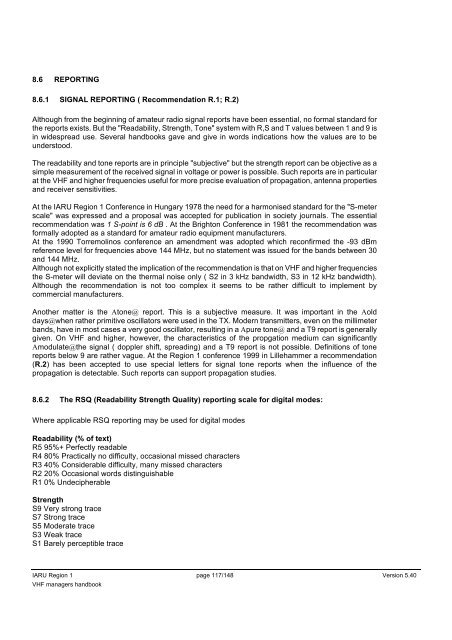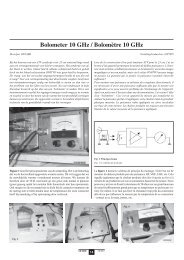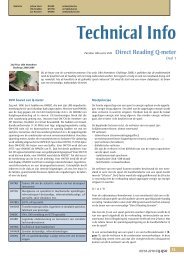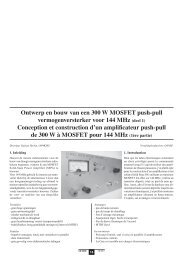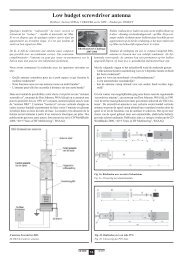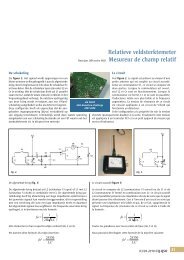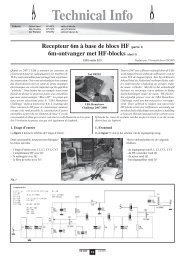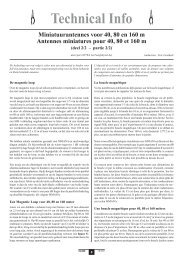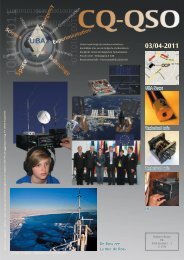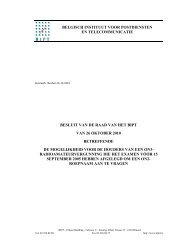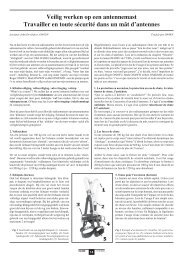IARU Region 1 VHF Managers Handbook - UBA
IARU Region 1 VHF Managers Handbook - UBA
IARU Region 1 VHF Managers Handbook - UBA
Create successful ePaper yourself
Turn your PDF publications into a flip-book with our unique Google optimized e-Paper software.
8.6 REPORTING<br />
8.6.1 SIGNAL REPORTING ( Recommendation R.1; R.2)<br />
Although from the beginning of amateur radio signal reports have been essential, no formal standard for<br />
the reports exists. But the "Readability, Strength, Tone" system with R,S and T values between 1 and 9 is<br />
in widespread use. Several handbooks gave and give in words indications how the values are to be<br />
understood.<br />
The readability and tone reports are in principle "subjective" but the strength report can be objective as a<br />
simple measurement of the received signal in voltage or power is possible. Such reports are in particular<br />
at the <strong>VHF</strong> and higher frequencies useful for more precise evaluation of propagation, antenna properties<br />
and receiver sensitivities.<br />
At the <strong>IARU</strong> <strong>Region</strong> 1 Conference in Hungary 1978 the need for a harmonised standard for the "S-meter<br />
scale" was expressed and a proposal was accepted for publication in society journals. The essential<br />
recommendation was 1 S-point is 6 dB . At the Brighton Conference in 1981 the recommendation was<br />
formally adopted as a standard for amateur radio equipment manufacturers.<br />
At the 1990 Torremolinos conference an amendment was adopted which reconfirmed the -93 dBm<br />
reference level for frequencies above 144 MHz, but no statement was issued for the bands between 30<br />
and 144 MHz.<br />
Although not explicitly stated the implication of the recommendation is that on <strong>VHF</strong> and higher frequencies<br />
the S-meter will deviate on the thermal noise only ( S2 in 3 kHz bandwidth, S3 in 12 kHz bandwidth).<br />
Although the recommendation is not too complex it seems to be rather difficult to implement by<br />
commercial manufacturers.<br />
Another matter is the Atone@ report. This is a subjective measure. It was important in the Aold<br />
days@when rather primitive oscillators were used in the TX. Modern transmitters, even on the millimeter<br />
bands, have in most cases a very good oscillator, resulting in a Apure tone@ and a T9 report is generally<br />
given. On <strong>VHF</strong> and higher, however, the characteristics of the propgation medium can significantly<br />
Amodulate@the signal ( doppler shift, spreading) and a T9 report is not possible. Definitions of tone<br />
reports below 9 are rather vague. At the <strong>Region</strong> 1 conference 1999 in Lillehammer a recommendation<br />
(R.2) has been accepted to use special letters for signal tone reports when the influence of the<br />
propagation is detectable. Such reports can support propagation studies.<br />
8.6.2 The RSQ (Readability Strength Quality) reporting scale for digital modes:<br />
Where applicable RSQ reporting may be used for digital modes<br />
Readability (% of text)<br />
R5 95%+ Perfectly readable<br />
R4 80% Practically no difficulty, occasional missed characters<br />
R3 40% Considerable difficulty, many missed characters<br />
R2 20% Occasional words distinguishable<br />
R1 0% Undecipherable<br />
Strength<br />
S9 Very strong trace<br />
S7 Strong trace<br />
S5 Moderate trace<br />
S3 Weak trace<br />
S1 Barely perceptible trace<br />
<strong>IARU</strong> <strong>Region</strong> 1 page 117/148 Version 5.40<br />
<strong>VHF</strong> managers handbook


